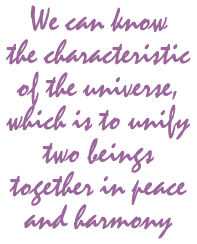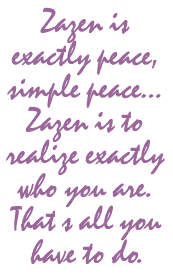|
Art of Zazen
Zazen is sitting meditation. In Japanese, za means sitting; zen means tranquillity. I use the term zazen because the meditation we do is a little different from the meditation other religions do. In Chinese, za means "two persons sitting in the universe." You cannot sit alone, in your own egoistic, selfish territory. You must open yourself and sit in the universe, with all sentient beings. That sitting is zen, tranquillity. The universe, the earth, all beings and all circumstances are sitting with you. All we have to do is do our best to sit in the universe with all sentient beings. Don't expect anything special, anything extra besides this. There are three points we have to follow in zazen:
For zazen we use these round cushions. If you don't have a cushion under you when you sit, your center of gravity is around your hips, and if you fall asleep you fall down because this posture is very unstable. If you sit this way it seems comfortable, but it's not really comfortable as a whole because it stresses your intestines, your heart and your lungs. You cannot breathe well, you cannot keep in balance, and you cannot sit for long. You cannot really concentrate on sitting. It's very difficult to become tranquil.
There are two postures which we use: the half-lotus, in which you place your right leg on your left thigh or your left leg on your right thigh; and the full lotus, where you put your feet up on your thighs. Your weight is put on three points: your two knees on the square cushion (zabuton), and your hips on the round cushion (zafu). Next put your hands, palms up, on your knees. Then take a deep breath; open your mouth just slightly and inhale, letting the breath in through your mouth. As you inhale, arch your body backward a little bit, stretching the front; do this very slowly, with full attention. And when you exhale, arch your body forward, letting out all the inhaled breath from your lower abdomen. Then repeat this, but this time lean to the right as you exhale, stretching out the left side of your body. Inhale again as you bring your body back to the center. Then repeat this, swaying from right to left, leaning a little less each time, as your motion goes from large to small. This prepares you for your sitting, physically and mentally. Then place your left hand, palm upward, on your right palm, and touch your thumbs together right above your middle finger, making the form of an ellipse, not a circle or a square. You should make a very soft, gentle form; it shouldn't feel loose or tense. This is called the cosmic mudra, the symbol of the cosmic universe. We can know the characteristic of the universe, which is to unify two beings together in peace and harmony. The universe must be one with you, with your center of gravity. That center of gravity is always your lower abdomen. Touch this universe to your abdomen, and place your hands a few inches below your navel. Your arms go forward a little bit, not touching the sides of your body. It's as if you were holding raw eggs under your armpits, neither crushing nor dropping them. Then, very naturally, your arms will be relaxed. Next, push your lower back forward a little bit. This practice might be a little hard for you if you have never done it before, but don't worry about it. Straighten your lower back and your head, keeping your neck parallel with the wall. Then, without moving your neck, pull your chin in so that it feels like you're pushing the ceiling with the top of the back of your head. Very naturally, your back becomes taut, just like putting a straight stick from the top of your head to the bottom of your spine. Cast your eyes naturally on the floor and gaze at a place in a wide area of the floor. Don't pick out a specific spot. Just cast down your eyes. This area should be about the same distance from your center of gravity as your sitting height. Open your eyes slightly; not wide, not closed. If you close your eyes, you'll visualize things, and you'll create some trouble. If you open your eyes too much, that is also trouble... your mind scatters. In the beginning of zazen, if it is difficult to take care of your mind, you can close your eyes for a while. But as soon as possible you should open them again. When you take this posture, your nose and navel are in a vertical line and your ears and shoulders are in a horizontal line. You are not leaning forward, you are not leaning backward; you are not leaning to the right or to the left. You are exactly straight up, just like a mountain. Next, bring your teeth together and your lips together. Your mouth is closed. Your tongue should touch the roof of your mouth as naturally as you can. Let breath in through your nose and let it go down to your lower abdomen; then let all the breath out through your nose, slowly. Repeat this breathing. When you have proper physical posture, your breath goes in and out very naturally from you nose to your lower abdomen, without stopping on the way. If you pay attention to your respiration, it goes a little bit more slowly than usual. That's fine. If you have a problem with your breath, let it go, just breathe naturally for a while. Don't worry about good breathing or bad breathing... don't worry about judgment. If you become irritated in trying to control your breath, you create problems. Next comes harmonizing your mind. The mind is really busy, like a monkey. So take care of your mind. Let your monkey mind sit zazen together with you constantly. If you let it go, it runs wild. Don't let it go.
Always your mind must be with your breath... the mind goes off immediately. At the time bring it back to your zazen. Very often your mind is just like a wild child, always screaming and going out. But you must be just like a mother, always taking her back. I don't know how often you have to take her back to your zazen; maybe during the whole time you are doing zazen. When the mind goes out, take it back... going out and taking it back, always. All you have to do is see where the mind is. Do your best. That's all you have to do. This is zazen. If you harmonize your breath and harmonize your mind, if you keep the functioning of your brain stem completely in balance, you create a strong feeling of being present right now, right here. Your cerebral cortex works very naturally and smoothly, your hormones function well, your breathing is good, your mind becomes tranquil, and you feel strong vitality. Through this practice of zazen, you can be exactly present completely beyond your likes or dislikes; at the same time, you can realize vitality. But whatever kind of energy comes up, just continue to sit, keeping balance. Just let it go, just be with it. So, very naturally, your body and mind are characterized by homeostasis, constantly keeping balance. When zazen is over, release the posture of your hands... the cosmic mudra. Put your hands on your knees, palms upward, and lean a little to the right, then to the left, leaning more each time, going from small motion to large. First drop your head to your right shoulder as you exhale and lean to the right. Then bring your head back to the center as you inhale and straighten up. Drop your head to your left shoulder as you exhale and lean to the left, and inhale and bring you head and body back to the center. Repeat this, swinging from small motion to large. Then release the position of your legs and stretch them out. Now you can stand up. You can fit your life into human society through this experience of zazen. When you bring your mind and body into human society, they are very calm and balanced. You can help others through this situation of your body and mind, even though you don't say anything. You can really experience this feeling of being present stably and securely. You can help other people in this way, and you can also help yourself. You can really enjoy yourself. But this can be a problem, the problem of "I am a great person"... that is ego. Or there can be a very strong desire: "I want to help this person; I want to be a good person; wherever I go I want to do zazen." So sometimes you kick out anyone who interrupts you. You don't care about your family, your education, your job. You become selfish. If you attach to the good aspects of your experience through zazen, you create certain expectations: enlightenment, insight, peace... endless desire. At that time you cannot become peaceful because you want more and more. Finally, all you have to do is forget it. Day by day, just keep this practice, on and on, without expectation. Zazen is exactly peace, simple peace. There is nothing around zazen to touch it. Zazen is to realize exactly who you are. That's all you have to do. Whatever you experience, forget it. All you have to do is carry it forever, just like the water of the Ganges River, just flowing. That is really great power, supporting your life, behind your life. You don't see it, but it's really a great help. It's spiritual security. But don't worry about this; don't hang on to it. All you have to do is just carry your zazen. Zen Master Dogen said, "This experience should be shared not only with your friends, but with all sentient beings." Whatever you can have, whatever you can do, carry it with all sentient beings. That is a great practice for us. That is spiritual security. That is deepening your life. |

 So even though you may not feel comfortable at first sitting straight, it's pretty good for you. Posture is very important. That's why we use these cushions. If you sit on one of these cushions, your zazen forms a three dimensional triangle, and your center of gravity is right in the center of the triangle. It makes your posture very stable.
So even though you may not feel comfortable at first sitting straight, it's pretty good for you. Posture is very important. That's why we use these cushions. If you sit on one of these cushions, your zazen forms a three dimensional triangle, and your center of gravity is right in the center of the triangle. It makes your posture very stable.
 Your mind should be with your breath. When you inhale, concentrate on your lower abdomen going out; when you exhale, concentrate on your lower abdomen going in. Or you can do the reverse... when you inhale your lower abdomen can go in, and when you exhale your lower abdomen goes out. When you feel sleepy or lazy, this wakes you up sometimes.
Your mind should be with your breath. When you inhale, concentrate on your lower abdomen going out; when you exhale, concentrate on your lower abdomen going in. Or you can do the reverse... when you inhale your lower abdomen can go in, and when you exhale your lower abdomen goes out. When you feel sleepy or lazy, this wakes you up sometimes.